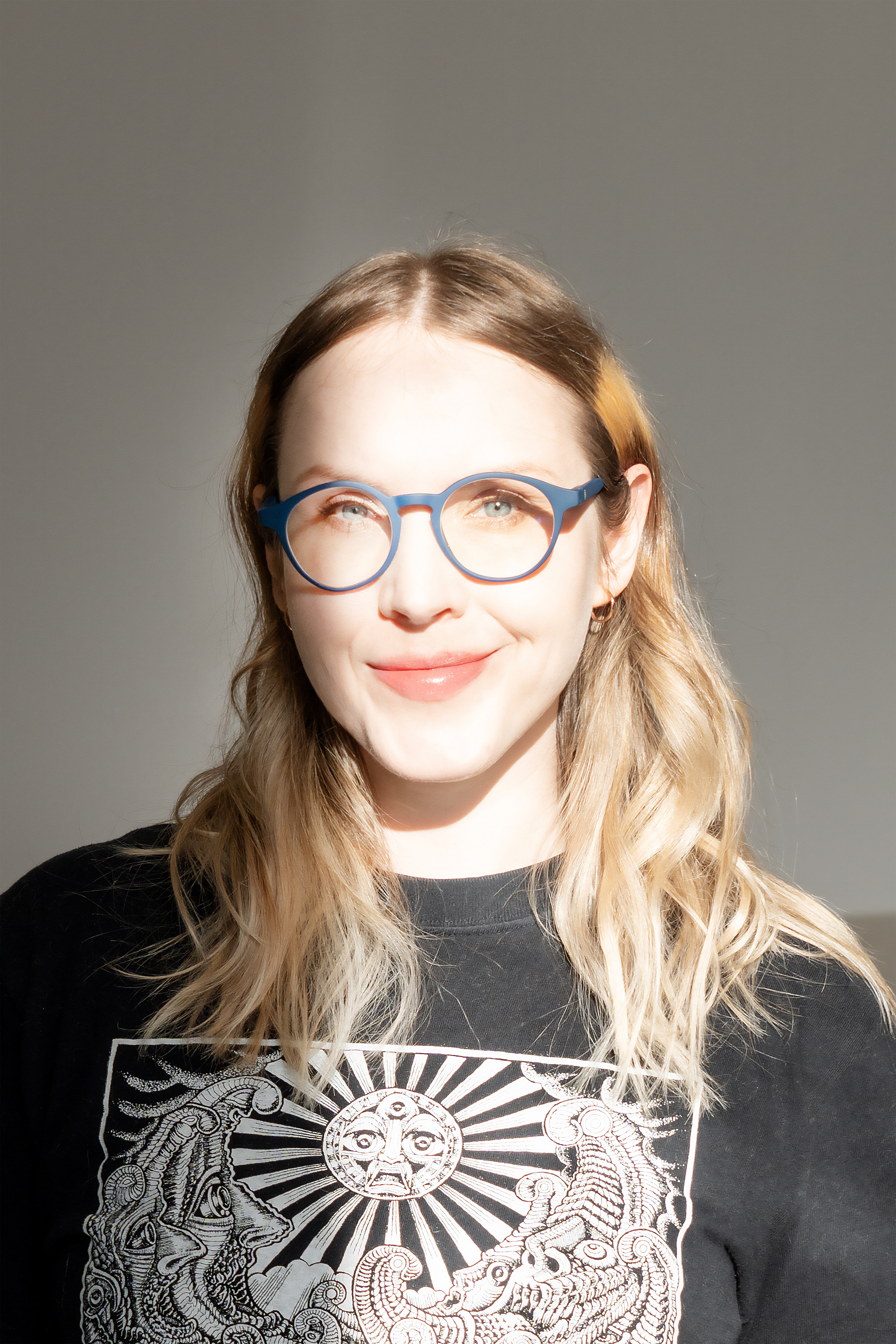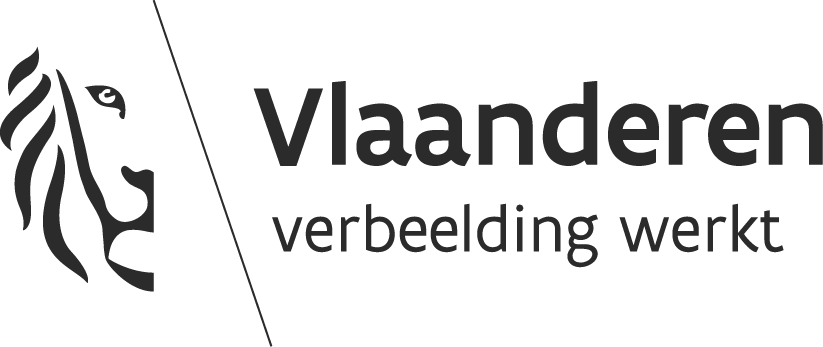Publiek Park 2025
Līga Spunde
NL
Eden is exhausted too, 2025
Dessin numérique
Dessin numérique
Placées de part et d’autre de l’entrée du Palais des Plantes, deux bannières dépeignent des mondes fictifs peuplés de créatures mystérieuses, intitulées Eden is exhausted too. L’une des références de ces peintures numériques est l’œuvre de Jérôme Bosch, en particulier le triptyque Le Jardin des délices terrestres. Faisant écho à l’iconographie spatiale d’un retable, les panneaux de gauche et de droite du chef-d’œuvre de Bosch représentent respectivement les sauvés et les damnés.
Une autre source d’inspiration clé dans l’œuvre de Līga Spunde est le domaine de la cryptozoologie, qui a vu le jour en Belgique avec des figures centrales telles que Bernard Heuvelmans et Alika Lindbergh. Définie comme une pseudo-science et une sous-culture, la cryptozoologie étudie les espèces animales folkloriques ou éteintes dont l’existence reste contestée ou non vérifiée.
Les mondes décrits dans les peintures de Spunde résonnent avec la multitude de biomes représentés dans le vaste complexe de serres, faisant allusion à des créatures non identifiées et insaisissables qui pourraient les peupler. Certaines de ces entités semblent s’être échappées des peintures et sont dispersées, sous forme de sculptures, sur le terrain de Plantentuin Meise. Les visiteurs sont invités à découvrir ces créatures au cours de leur voyage dans le jardin botanique, en suivant les indices codés dans l’imagerie.
Une autre source d’inspiration clé dans l’œuvre de Līga Spunde est le domaine de la cryptozoologie, qui a vu le jour en Belgique avec des figures centrales telles que Bernard Heuvelmans et Alika Lindbergh. Définie comme une pseudo-science et une sous-culture, la cryptozoologie étudie les espèces animales folkloriques ou éteintes dont l’existence reste contestée ou non vérifiée.
Les mondes décrits dans les peintures de Spunde résonnent avec la multitude de biomes représentés dans le vaste complexe de serres, faisant allusion à des créatures non identifiées et insaisissables qui pourraient les peupler. Certaines de ces entités semblent s’être échappées des peintures et sont dispersées, sous forme de sculptures, sur le terrain de Plantentuin Meise. Les visiteurs sont invités à découvrir ces créatures au cours de leur voyage dans le jardin botanique, en suivant les indices codés dans l’imagerie.
EN
Eden is exhausted too, 2025
Digital drawing
Digital drawing
Placed on both sides of the entrance to the Plant Palace, two banners depict fictional worlds inhabited by mysterious creatures, titled Eden is exhausted too. One of the references for these digital drawings is the work of Hieronymus Bosch, specifically the triptych The Garden of Earthly Delights. Echoing the spatial iconography of an altarpiece, the left and right panels of Bosch’s masterpiece depict the saved and the damned, on each side respectively.
Another key source of inspiration in Līga’s work is the field of cryptozoology, which originated in Belgium with central figures such as Bernard Heuvelmans and Alika Lindbergh. Defined as a pseudoscience and subculture, cryptozoology studies folkloric or extinct animal species whose existence remains disputed or unverified.
The worlds depicted in Spunde’s drawings resonate with the multitude of biomes represented in the vast greenhouse complex, alluding to unidentified and elusive creatures that might dwell within them. Some of these beings appear to have escaped the drawings, dispersed as sculptures across the grounds of Plantentuin Meise. The visitors are invited to discover these creatures on their journey through the botanic garden, following clues encoded in the imagery.
Another key source of inspiration in Līga’s work is the field of cryptozoology, which originated in Belgium with central figures such as Bernard Heuvelmans and Alika Lindbergh. Defined as a pseudoscience and subculture, cryptozoology studies folkloric or extinct animal species whose existence remains disputed or unverified.
The worlds depicted in Spunde’s drawings resonate with the multitude of biomes represented in the vast greenhouse complex, alluding to unidentified and elusive creatures that might dwell within them. Some of these beings appear to have escaped the drawings, dispersed as sculptures across the grounds of Plantentuin Meise. The visitors are invited to discover these creatures on their journey through the botanic garden, following clues encoded in the imagery.
FR
Eden is exhausted too, 2025
Digitale tekening
Digitale tekening
Aan beide zijden van de ingang van het Plantenpaleis hangen twee banners die fictieve werelden tonen, bevolkt door mysterieuze wezens. Het werk draagt de titel Eden is exhausted too. Een belangrijke referentie voor deze digitale tekeningen is het werk van Jheronimus Bosch, in het bijzonder het drieluik De tuin der lusten. Net als bij een altaarstuk, tonen de linker- en rechterpanelen van Bosch' meesterwerk respectievelijk de geredden en de verdoemden - een ruimtelijke iconografie die in dit werk weerklinkt.
Een andere belangrijke inspiratiebron in Līga Spunde’s werk is het onderzoeksgebied van de cryptozoölogie, een discipline die zijn oorsprong vond in België met centrale figuren als Bernard Heuvelmans en Alika Lindbergh. Cryptozoölogie - vaak bestempeld als pseudowetenschap en subcultuur - onderzoekt folkloristische of uitgestorven diersoorten waarvan het bestaan omstreden of onbevestigd blijft.
De werelden in Spunde’s tekeningen sluiten aan bij de veelheid aan biomen die samenkomen in het uitgestrekte serrecomplex, en verwijzen naar onbekende, onzichtbare wezens die zich daar mogelijk schuilhouden. Sommige van deze entiteiten lijken uit de schilderijen te zijn ontsnapt om zich als sculpturen te verspreiden over het terrein van de Plantentuin. Bezoekers worden uitgenodigd om deze wezens te ontdekken tijdens hun wandeling, aan de hand van aanwijzingen die verborgen zitten in de afbeeldingen.
Een andere belangrijke inspiratiebron in Līga Spunde’s werk is het onderzoeksgebied van de cryptozoölogie, een discipline die zijn oorsprong vond in België met centrale figuren als Bernard Heuvelmans en Alika Lindbergh. Cryptozoölogie - vaak bestempeld als pseudowetenschap en subcultuur - onderzoekt folkloristische of uitgestorven diersoorten waarvan het bestaan omstreden of onbevestigd blijft.
De werelden in Spunde’s tekeningen sluiten aan bij de veelheid aan biomen die samenkomen in het uitgestrekte serrecomplex, en verwijzen naar onbekende, onzichtbare wezens die zich daar mogelijk schuilhouden. Sommige van deze entiteiten lijken uit de schilderijen te zijn ontsnapt om zich als sculpturen te verspreiden over het terrein van de Plantentuin. Bezoekers worden uitgenodigd om deze wezens te ontdekken tijdens hun wandeling, aan de hand van aanwijzingen die verborgen zitten in de afbeeldingen.

NL
Līga Spunde (1990, Letland) is een kunstenaar gevestigd in Riga. Ze werkt voornamelijk met installaties die bestaan uit video, digitale prints en sculpturale elementen. Haar werk is geïnspireerd op persoonlijke verhalen, waarbij de inhoud sterk bepalend is voor de fysieke vorm van het werk. Die verhalen verwerkt ze tot verschillende vormen van fictie, met terugkerende personages die verwijzen naar echte mensen of ervaringen. Zo staan haar digitale tekeningen van overdreven, bijna monsterlijke figuren symbool voor bestaande personen, en verbeelden theatrale sculpturen gebeurtenissen die echt zijn gebeurd. Vanuit deze narratieven onderzoekt ze thema’s als het gedigitaliseerde lichaam en de relatie tot sociale media, photoshop of plastische chirurgie. Door een nauwe verweving van zorgvuldig geconstrueerde fictie en werkelijkheid ontstaan gelaagde scènes waarin Spunde een unieke visuele taal ontwikkelt.
Het werk van Līga Spunde wordt ondersteund door het Cultureel Kapitaalfonds van de Letse Staat (VKKF).
Līga Spunde (1990, Letland) is een kunstenaar gevestigd in Riga. Ze werkt voornamelijk met installaties die bestaan uit video, digitale prints en sculpturale elementen. Haar werk is geïnspireerd op persoonlijke verhalen, waarbij de inhoud sterk bepalend is voor de fysieke vorm van het werk. Die verhalen verwerkt ze tot verschillende vormen van fictie, met terugkerende personages die verwijzen naar echte mensen of ervaringen. Zo staan haar digitale tekeningen van overdreven, bijna monsterlijke figuren symbool voor bestaande personen, en verbeelden theatrale sculpturen gebeurtenissen die echt zijn gebeurd. Vanuit deze narratieven onderzoekt ze thema’s als het gedigitaliseerde lichaam en de relatie tot sociale media, photoshop of plastische chirurgie. Door een nauwe verweving van zorgvuldig geconstrueerde fictie en werkelijkheid ontstaan gelaagde scènes waarin Spunde een unieke visuele taal ontwikkelt.
Het werk van Līga Spunde wordt ondersteund door het Cultureel Kapitaalfonds van de Letse Staat (VKKF).
EN
Līga Spunde (1990, Latvia) is an artist based in Riga. She works primarily in installation, made up of video, digital print and sculpture components. These multimedia installations are inspired by personal narratives, the content of which strongly defines the physical form of the work. Spunde re-interprets these narratives through constructed fictions, where repeated, recognisable characters serve as extensions of real experiences. Digital drawings of exaggerated, monstrous figures symbolise actual people; theatrical sculptures replicate real-life stories. Building on represented narratives, these figures explore ideas such as the digitised body and its relationship to social media, Photoshop or plastic surgery. A close intersection of carefully constructed fictions and realities produces complex scenes in which Spunde has developed a unique visual language.
The work of Līga Spunde is supported by the State Culture Capital Foundation of Latvia (VKKF).
Līga Spunde (1990, Latvia) is an artist based in Riga. She works primarily in installation, made up of video, digital print and sculpture components. These multimedia installations are inspired by personal narratives, the content of which strongly defines the physical form of the work. Spunde re-interprets these narratives through constructed fictions, where repeated, recognisable characters serve as extensions of real experiences. Digital drawings of exaggerated, monstrous figures symbolise actual people; theatrical sculptures replicate real-life stories. Building on represented narratives, these figures explore ideas such as the digitised body and its relationship to social media, Photoshop or plastic surgery. A close intersection of carefully constructed fictions and realities produces complex scenes in which Spunde has developed a unique visual language.
The work of Līga Spunde is supported by the State Culture Capital Foundation of Latvia (VKKF).
FR
Līga Spunde (1990, Lettonie) est une artiste basée à Riga. Elle travaille principalement dans le domaine de l’installation, composée de vidéo, d’impression numérique et de sculpture. Ces installations multimédias s’inspirent de récits personnels, dont le contenu définit fortement la forme physique de l’œuvre. Spunde réinterprète ces récits à travers des fictions construites, où des personnages récurrents et familiers servent de prolongement à des expériences réelles : des dessins numériques de figures exagérées et monstrueuses symbolisent des personnes réelles ; des sculptures théâtrales reproduisent des histoires vécues. S’appuyant sur des récits représentés, ces figures explorent des idées telles que le corps numérisé et sa relation avec les médias sociaux, Photoshop ou la chirurgie plastique. Le croisement étroit entre fictions et réalités soigneusement construites produit des scènes complexes dans lesquelles Līga Spunde développe un langage visuel unique.
Le travail de Līga Spunde est soutenu par la Fondation nationale pour la culture de Lettonie (VKKF).
Līga Spunde (1990, Lettonie) est une artiste basée à Riga. Elle travaille principalement dans le domaine de l’installation, composée de vidéo, d’impression numérique et de sculpture. Ces installations multimédias s’inspirent de récits personnels, dont le contenu définit fortement la forme physique de l’œuvre. Spunde réinterprète ces récits à travers des fictions construites, où des personnages récurrents et familiers servent de prolongement à des expériences réelles : des dessins numériques de figures exagérées et monstrueuses symbolisent des personnes réelles ; des sculptures théâtrales reproduisent des histoires vécues. S’appuyant sur des récits représentés, ces figures explorent des idées telles que le corps numérisé et sa relation avec les médias sociaux, Photoshop ou la chirurgie plastique. Le croisement étroit entre fictions et réalités soigneusement construites produit des scènes complexes dans lesquelles Līga Spunde développe un langage visuel unique.
Le travail de Līga Spunde est soutenu par la Fondation nationale pour la culture de Lettonie (VKKF).

